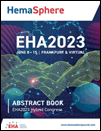P1064: BRENTUXIMAB VEDOTIN, NIVOLUMAB, DOXORUBICIN, AND DACARBAZINE FOR ADVANCED STAGE CLASSICAL HODGKIN LYMPHOMA: UPDATED EFFICACY AND SAFETY RESULTS FROM THE SINGLE ARM PHASE 2 STUDY
Abstract Topic: 17. Hodgkin lymphoma - Clinical
Background: Brentuximab vedotin (BV) is an antibody-drug conjugate approved for multiple cancer types, including previously untreated, adult, stage III or IV classical Hodgkin lymphoma (cHL), in combination with doxorubicin, vinblastine, and dacarbazine (AVD). BV and nivolumab (N) are both individually active and well tolerated in patients with cHL and have distinct and complementary mechanisms of action. BV and nivolumab have been previously studied in combination and with multiagent chemotherapy as BV+AD (omitting vinblastine) and N+AVD. It was hypothesized that the combination of BV and nivolumab with doxorubicin and dacarbazine (AN+AD) would result in high response rates and a well-tolerated safety profile, with potentially less toxicity than vinblastine-containing regimens. SGN35-027 (NCT03646123; EudraCT Number 2020-004027-17; Part B) is an open-label, multiple part, multicenter, phase 2 clinical trial. Preliminary results of this study showed promising efficacy (objective response rate [ORR] 93%; complete response [CR] rate 88% at end of therapy [EOT]) with no cases of febrile neutropenia or Grade 5 adverse events (AEs) (Lee ASCO 2022).
Aims: Present updated safety and efficacy results of AN+AD as frontline treatment for patients with advanced stage cHL
Methods: Part B enrolled patients with stage II bulky mediastinal disease (≥10 cm), stage III, or stage IV cHL. Patients received up to 6 cycles of AN+AD (BV 1.2 mg/kg [A], nivolumab 240 mg [N], doxorubicin 25 mg/m2 [A], and dacarbazine 375 mg/m2 [D]). The primary efficacy endpoint was CR rate at EOT. Key secondary endpoints included safety and tolerability, ORR, duration of response (DOR), duration of complete response (DOCR), and progression-free survival (PFS). Disease response and progression were assessed by investigator using Lugano Classification Revised Staging System for malignant lymphoma, incorporating Lymphoma Response to Immunomodulatory Therapy Criteria for nodal non-Hodgkin and Hodgkin lymphomas.
Results: Fifty-eight patients were enrolled; all but 1 patient received ≥1 dose of study drug. Among efficacy evaluable patients (n=56), ORR (CR+partial response [PR]) at EOT was 95% (95% CI: 85.1, 98.9); CR rate was 89% (95% CI: 78.1, 96.0). DOR of at least 15 months occurred in 92.7% (95% CI: 81.6, 97.9) of responders. Six (11%) patients had a PFS event: 5 disease progression, 1 death (sepsis, outside safety reporting period). The estimated PFS rate at 18 months was 92.6% (95% CI: 81.5, 97.2). Median follow-up was 18.8 months (95% CI: 17.9, 22.5).
Treatment-related AEs occurred in 56 (98%) patients; Grade ≥3 treatment-related AEs occurred in 19 (33%) patients. No febrile neutropenia or Grade 5 AEs occurred. Treatment-related serious AEs (SAEs) occurred in 8 (14%) patients. No patients died due to a treatment-related SAE. Treatment-emergent immune-mediated AEs (IMAEs) occurred in 20 (35%) patients; treatment-emergent IMAEs occurring in ≥5% of patients were hypothyroidism (5 [9%]), pneumonitis and rash maculo-papular (3 [5%] each). As of data cutoff (28 Nov 2022), all patients were off study drug; 51 (88%) remained in long-term follow-up.
Summary/Conclusion: The use of two active, targeted agents with distinct and complementary mechanisms of action for the frontline treatment of advanced stage cHL resulted in promising activity, safety, and tolerability. Updated safety results demonstrated continued tolerability of AN+AD with no new safety signals observed. AN+AD may provide a future frontline treatment option for patients with advanced stage cHL; long-term follow-up is ongoing.
Keywords: Clinical trial, Hodgkin’s lymphoma, Phase II




